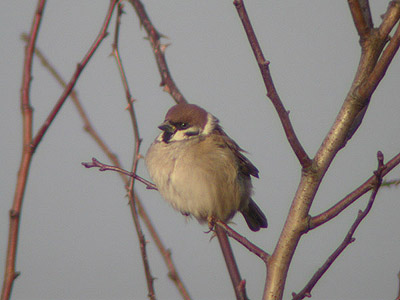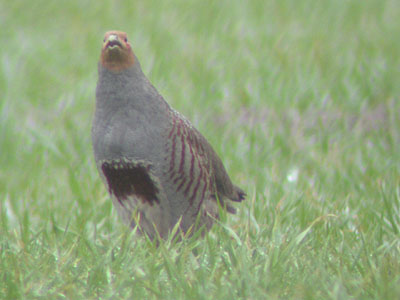

| Farmland birds - their present status in the area 2002 | ||
| All farmland birds are in national decline. Much of this can be attributed to modern-day farming practises - herbicide and pesticide use, wide-scale hedge removal, ploughing up of former meadowland and the in-filling and draining of ponds and ditches. | ||
| .... | ||
 |
The most dangerously
threatened are Sky Lark, Grey Partridge, Tree Sparrow,
Lapwing, Corn Bunting and Turtle Dove. All, with the
exception of the Corn Bunting are found here and are only
just managing to sustain tenuous footholds, although the
Sky Lark has presented an increased since 1998. The area's overall low breeding populations of these species, may come as something of a surprise to many. Results from the breeding surveys carried out between 1998 and 2002, show that of the five species listed, only the Sky Lark has managed a real increase in numbers, with pair counts rising to double the original count made in 1998. This raises the question as to why the Sky Lark has been more successful ? The Sky Lark and Turtle Dove were found to be the most sedentary of all in their choice of breeding localities, both showing distinct preferences for nesting in the same part of the recording area each year. |
|
| .... | ||
| For the Sky
Lark, this may be an entire four acre field and for the
Turtle Dove, a small area of mature Hawthorn scrubland or
hedgerow. The Turtle Dove's more specific habitat
requirements, possibly prevents any great future increase
here and the Sky Lark looks set to remain the commonest
breeder from the list, because of the greater extent of
nesting habitat. Unoccupied and suitable Turtle Dove
habitat is limited, but available and this is likely to
have a great effect on future Turtle Dove breeding
counts. The other three species, were all found to be
much more mobile in their choice of nest site. With virtually no competition from other males, Grey Partridges seem to be able to hold large territories which consequently contain more suitable nest sites. But with a population ranging from just one-three pairs, it's future here looks decidedly tenuous compared to the commoner Red-legged Partridge. |
||
| .... | ||
| The three Grey Partridge
pairs found in 2001, have continued to be successful into
2002 at widely scattered locations near Red Hill, Eakring
Flash and Tug Bridge Farm. Tree Sparrows remain very rare here and aside from the regular breeding birds, most sightings involve Autumn migrants. It's status as a breeding bird is of grave concern and the population has been restricted to less than three pairs during the five year study. To date, only one reasonably large Tree Sparrow flock has occurred since 1998 - that of 21 birds around Tug Bridge Farm from September 21-October 4th, 2001. Evidence found during breeding surveys, suggests that the Lapwing has been forced to adopt a more opportunistic approach to nesting, especially since the onset of Autumn cereal sowing. A lack of any true nest, probably also makes them better adapted to this. |
 |
|
| .... | ||
| Many breeding
attempts since 1998 have resulted in failure, primarily
due to nest destruction by modern farm machinery and
pairs have been noted to make at least three attempts in
the past, before successfully producing young. A method
used to some effect in the past, has been the temporary
"lifting" of nests ahead of cultivating
machinery, before being moved back to their original
location. More use of this lifting method over the coming
years, is likely to be one of the key factors if Lapwing
are to make any real, permanent comeback as a breeding
bird here. Out of 15 successful breeding pairs in the area since 1998, the preferred nest sites of 14 of these were in type A and type C set-aside (predominantly open, bare or sparsely vegetated) fields or germinating Sugar-Beet crops. Quite often, male territories were within close proximity and on several occasions, a single field held up to seven pairs. It can be assumed that breeding Lapwing numbers will remain low here because of a limited availability of the preferred nesting habitat. Encouraging farmland birds back to the Eakring and Kersall area The key factor is a return to a greater farming/wildlife co-operation. There has to be changes in modern farm practices to encourage an up-turn in numbers of our farmland birds and insects. These don't necessarily have to be on a large-scale basis. Reductions in herbicide and insecticide use, a rotational set-aside system, the replanting of some former hedgerows and copses. There are many ways this can happen, which has little or no effect on farm income. Even the smallest changes can have an enormous effect on wildlife. One has to accept that there will be no return to the greater percentage of meadowland, once within the area. But that fact, should not rule out any possibility of the return of former breeding birds like Corn Bunting, Snipe and Barn Owl. All very likely, with some more careful land management. One highly effective but simple scheme, is to leave a strip of land free from herbicides around field edges and especially alongside hedgerows. More details on this can be found here. The preservation and encouragement of the hedgerow habitat is important. Hedgerows that contain Bramble, Nettle and a variety of other wild flowers, promote a far greater biologically diverse habitat, affording protection and feeding to a range of wildlife and wind protection to crops. They also create natural migratory corridors for the movement of birds and allows insects to colonise other areas more easily. Hedgerows dividing cultivated areas from farm tracks or bridle paths, are often as acutely diverse one side, than from the other. In the area, there is a fine example of this along the bridle path which runs from a point immediately south of Kersall village, west-wards towards Park Farm. Hawthorn (Crategus monogyna) and to a greater extent, Blackthorn (Prunus spinosa) hedgerows could be maintained using biannual rotation sytem. Both are relatively slow growing and even if left for a year, their growth is unlikely to affect any crop yield or production. Breeding Snipe are only likely to return as a breeding bird at Eakring Flash and Eakring Meadows Nature Reserve. The latter site relies on more a more thoughtful (Snipe friendly) management policy, which links well, with the present system of meadowland management. Up until the 1990's, Barn Owl pairs numbered seven. Most of these were in the Eakring area, but have all disappeared and the only regular site is near Wellow, with very few sightings actually coming from well within the recording area. Suitable Barn Owl habitat still remains and artificial nest boxes situated strategically, would aid any comeback. Natural nest sites are now much fewer in these days of increasing outbuilding restoration and modernisation. A natural Corn Bunting recolonisation is likely in the future, providing available, existing habitat is maintained. Visiting bird watchers who came to the area for the large numbers of Quail and the Spotted Crake in 2001, were all very surprised to be told that both Corn Bunting and Barn Owl were absent as breeding birds here, but occurred only as transient visitors. Hopefully this trend can be reversed. |
||